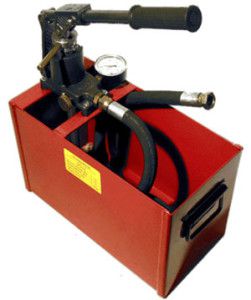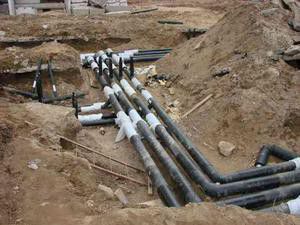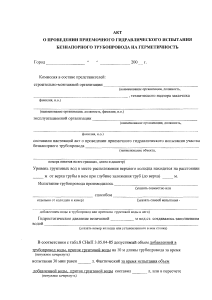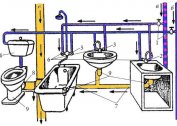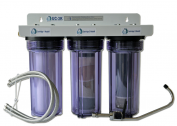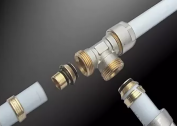Hydraulic tests are carried out after installation, they are mandatory for pressure and pressureless water supply networks. For testing, you need a pump that pumps in the water supply high pressure, revealing defects. The data obtained is entered into the water supply test certificate. Only after signing the act can water be used.
Purpose and Test Procedure
Hydraulic tests of water supply and sanitation systems are carried out to check the tightness, reliability of the water supply and the detection of defective parts. Testing is prescribed before the commissioning of the newly constructed network or after reconstruction (overhaul). All detected defects are immediately corrected, and the tests are repeated until a satisfactory result is obtained. Tests are done twice: first preliminary, after them final.
At the first stage, water is pumped into the water supply under pressure, the pressure should be one and a half times higher than the working one. Preliminary hydraulic tests of water supply pipelines are assigned with full access to the ground and underground parts of the highway, before the installation of plumbing fixtures.
Testing is scheduled before the final decoration. Hydraulic tests of water disposal and water supply systems are carried out by specialists from the plumbing service.
Before the final stage of hydraulic testing of water supply, underground sections are closed, all installation work on the segment is completed, but plumbing devices are not yet installed. The outputs are covered with plugs. During hydraulic tests of cold water supply, the pressure in the pipelines is increased by 1.3 times compared to the worker.
- Hydraulic tests of plastic water supply pipelines are allowed to be carried out one day after the end of installation, at positive temperature;
- To conduct hydraulic tests of weirs in the house, the pipes are completely filled with water to the top of the risers. Preliminary visually examine the condition of the pipes and correct noticeable flaws. If the completely filled weir system does not leak for 20 minutes and the water remains at the marked level, the system has passed the test.
Test conditions
It is necessary to carry out hydraulic tests of water supply and sanitation systems with all responsibility, realizing the complexity of the procedure. The test result largely depends on the literacy of their conduct. Therefore, they are trusted only by specialists who know the security measures and the requirements for such checks.
- The temperature in the room or on the street (if the external water supply is checked) is not lower than +5 degrees;
- The water supply is filled gradually, starting from the main section. Then water is poured into risers and small local networks;
- First, the lower floors are filled, gradually rising higher. This is necessary to displace air from the pipes and prevent the formation of air jams;
- At the end of the hydraulic tests, the used water is drained from the water supply and wastewater system;
- In hydraulic tests of hot water, temperature is measured at the extreme ends of the system. The calculated water is poured into the system;
- During the hydraulic tests of hot water supply, the condition of heated towel rails in the bathrooms is tested;
- If it is necessary to test the efficiency of the water supply, all points of use in the riser are simultaneously switched on. This test phase is optional.
Trial Progress
The procedure for preliminary hydraulic testing is regulated by the Building Standards and Rules:
- The water supply is filled and left without pressure for two hours.
- Slowly creates increased pressure for half an hour. Then you can check for leaks at the joints.
- The pressure decreases to the calculated indicators, the state of the track is examined.
- Under such a pressure of water, the route remains from 30 minutes or more to stabilize the deformed shape of the pipes.
- Introductory taps overlap and water is slowly drained from the pipes using a pressure pump.
- The track is checked for leaks and noticeable problems.
The water supply system has been successfully tested in the case when, at elevated pressure, no leaks, connections and fastening elements are found.
Before starting a hydraulic test of the water supply in an apartment building, you should find out the standard operating pressure, check with the pressure limits of the devices (collectors, hoses, filters, sensors).
Final Test Progress
In multi-apartment residential buildings, the final hydraulic test of a cold water pipe is carried out after the installation of plumbing devices:
- In the water supply, the working pressure is pumped and kept for two hours. If the pressure decreases by 0.02 MPa, it is raised to the initial mark.
- In 10 minutes, increase the pressure to test parameters and stand two hours.
Hydraulic tests of the cold water supply system are considered successful if the leak is not higher than the table.
| Dexternal pipe diameter, cm | Allowed leakage
liter \ min |
|
| For welded joints | For joints on gaskets (sockets) | |
| 6,3-7,5 | from 0.2 to 0.24 | from 0.3 to 0.5 |
| 9-11 | from 0.26 to 0.28 | from 0.6 to 0.7 |
| 12,5-14 | from 0.35 to 0.38 | from 0.9 to 0.95 |
| 16-18 | from 0.42 to 0.6 | from 1.05 to 1.2 |
| 20 | 0,56 | up to 1.4 |
| 25 | 0,7 | up to 1.55 |
| 28 | 0,8 | up to 1.6 |
| 31,5 | 0,85 | up to 1.7 |
| 35,5 | 0,9 | up to 1.8 |
| 40-45 | from 1.1 to 0.5 | from 1.95 to 2.1 |
| 50-56 | 1.1 to 1.15 | from 2.2 to 2.3 |
| 63 | 1,2 | up to 2.4 |
| 71 | 1,3 | up to 2.55 |
| 80 | 1,35 | up to 2.7 |
| 90 | 1,45 | up to 2.9 |
| 100 | 1,5 | until 3 |
| 120 | 1,6 | until 3 |
Table 1. Allowed leakage volumes on a 1 km water pipe
The data obtained as a result of hydraulic tests are brought into the acceptance certificate of the water supply system as detailed as possible. This also includes information about alterations and repairs made during the tests. The test certificate of water supply is a proof of the quality and excellent condition of the water supply system, readiness for operation.
At the end of hydraulic tests, the following documents are required for commissioning a cold or hot water supply system: working materials with notes on the features of the installation of the water supply system and the coincidence of the final result with the project, a description of the changes; hydraulic test certificate; an act describing hidden works.
Video on how to modify a cheap Chinese crimping pump:
